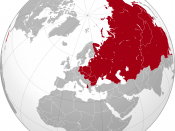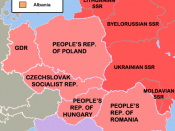The Cold War developed from disagreements on the postwar European world. The Soviet Union wanted to feel secure on the western border and did not want to give up what it had gained in Eastern Europe by defeating Germany. Eastern Europe was an area of disagreement in that the United States and Great Britain were in favor of democratic freedom for the liberated nations of Eastern Europe, however Stalin feared this would lead to traditional anti-Soviet attitudes if they were allowed free elections and he therefore was against the plans of the West. The Red Army proceeded to install pro-Soviet governing regimes in Poland, Romania, Bulgaria, and Hungary.
The civil war in Greece between the Communist People's Liberation Army and the anti-Communist forces over control of Greece led to the creation of the Truman Doctrine. It stated that if the Soviets were not stopped in Greece the US would have to face the spread of communism worldwide.
President Truman was concerned about the possibility of Soviet expansion, and the Truman Doctrine paved the way for US funding to countries who were threatened by it. The Marshall Plan was based on the belief that Communist aggression fed off economic turmoil and provided funding for the recovery of Europe. Albania, Bulgaria, Czechoslovakia, East Germany, Hungary, Poland, Romania, and the Soviet Union became a military alliance in the Warsaw Pact which was divided from NATO. At the end of World War II, the Soviets occupied all of Eastern Europe and the Balkans except for Greece, Albania, and Yugoslavia. Both Albania and Yugoslavia had Communist resistance movements during the war and the Communist Party assumed power when the war ended. Communist governments were placed in East Germany, Bulgaria, Romania, Poland, Hungary and later Czechoslovakia. Hungary attempted to become independent from Soviet control but was...


